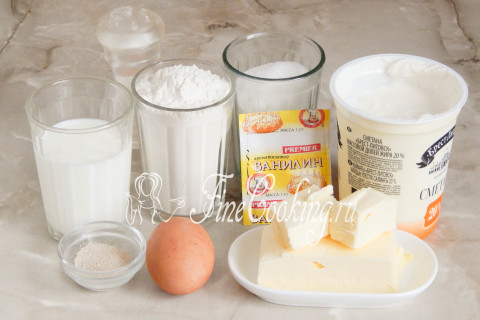Step 1
To prepare these delicate and incredibly tasty buns, you need very little ingredients and all of them are quite affordable. So, to prepare a hot yeast dough, we take the wheat flour of the highest grade, milk of any fat content (I have 2.5%), granulated sugar, butter (it must be taken out of the refrigerator and let it soften), a medium-sized chicken (about 45-50 grams), salt and high-speed yeast (I will write about yeast a little lower). In addition, for sour cream flooding, we need sour cream of any fat content (I use 20%), sugar, butter and a pinch of vanillin (can be replaced with a teaspoon of vanilla sugar).
Step 2
Let's start with the preparation of a hot yeast dough for the Rezniki. About yeast: it is not necessary to take precisely fast -acting ones — just dry are perfect (also 1 teaspoon without a hill, that is, under a knife — this is 3 grams) or pressed (it is needed 3 times more, that is, 9-10 grams). Such yeast is not immediately mixed with flour, but previously activated in a warm sweetish liquid for 10-15 minutes. In our case, you can slightly heat half a glass of milk with a tablespoon of sugar and dissolve the yeast in it. Since I used fast -acting, I added them immediately to the flour, which I pre -sought twice. We put 50 grams of sugar and half a teaspoon of fine salt there. We mix everything well so that dry ingredients are evenly distributed along the mixture.
Step 3
We make a recess in the center and pour warm (not hot, namely pleasant warm) milk into it. Add one chicken egg. Mix everything with your hand or spoon so that the flour is moistened.
Step 4
When you get such flour lumps, you can introduce soft butter. We begin the knead of the dough with our hands or with the help of dough (bread makers).
Step 5
To knead this butter of the yeast dough for quite a long time — at least 10 minutes, and even better longer. As a result, you will get a smooth, completely homogeneous dough. It is quite soft and very little sticky. Such a yeast dough holds its shape perfectly. In the process of kneading, you may need a little more or slightly less flour than I indicated in the ingredients — it depends on its humidity. We roll up the dough into the ball and leave it in a bowl (I am always my dishes in which the dough roams — I just do not like dirty), which is very slightly lubricated with vegetable oil without smell. We send the dough to heat for 1 hour, after which we make a light degree, re -rounding and again in heat for another 1 hour. In other words, our yeast dough will wander for 2 hours. Where is it better to wander the test and what does a warm place mean? There are several options — I try to write about this in almost every recipe with yeast pastries. First of all, in the oven with a light bulb turned on (it turns out about 28-30 degrees — the temperature ideal for fermentation of yeast dough). Then we tighten the bowl with the dough with cling film or cover with a towel made of natural fabric (flax is best suited) so that the surface does not be swollen and not covered with a crust. You can also let the dough wander in a microwave, in which we pre -boil a glass of water. The dough will rise with a door closed, and the glass will stand there. Then the bowl does not need to be closed with anything, since the water will evaporate, thereby maintaining the necessary humidity. Just make sure that no one inadvertently turns on the microwave, otherwise the dough will disappear and there will be no buns.
Step 6
After 1 hour, the dough is suitable — it will increase in volume at least by half. My process was not very active — probably the yeast did not come across the first freshness, although the deadlines on the packaging were quite acceptable.
Step 7
Directly crumple it, round it and again from heat for 1 hour.
Step 8
For the second time, the yeast dough should grow even more — exactly 3 times, and maybe 4 times. By the way, I want to talk a little about the time of fermentation of the yeast dough and the proofing of the workpieces. I hope you understand that this concept is relative. What does it mean? Well, for example, the recipe says that the test should be given to rest for 1 hour. You understand that 1 hour is the time that the author of this recipe was needed, that is, to me personally. +/- 10-15 minutes- quite acceptable deviation, the entire time of fermentation of the yeast test depends on many factors. Freshness (and as a result of activity) of yeast, the quality of flour, the temperature in the room, the amount of dough — this all affects the time of fermentation and proofing. Therefore, never clearly follow these recommendations — you must feel the dough, understand what he needs and then you will cook it purely intuitively.
Step 9
We take out the dough from the bowl and start cutting it. I advise you to immediately cut it into several parts — it will be more convenient.
Step 10
We take one piece of dough and roll a sausage from it, which, in turn, cut into small pieces — it is from the word to cut and the name of the dish (Rezniki) occurs. It is not necessary to fill the table with flour — the dough is almost not sticky.
Step 11
Of course, you can leave pieces of dough as they are — cut into slices, but I like it more when the ruddy colobes are obtained. Therefore, I roll each piece of dough into a ball — it turns out a workpiece the size of a walnut. So divide all the dough into pieces of the same size and, if desired, roll them into balls.
Step 12
We shift the baking koloboks to the baking sheet, which it is advisable to cover with baking paper (lubricate it very little with refined vegetable oil). We cover the workpieces with a light towel made of natural fabric or cling film. We leave in a warm place for 30 minutes.
Step 13
When the workpieces grow up (the photo is not very visible, but the pebbles were swollen and rounded), they still bake them. Before planting in the oven, you can sprinkle the colobes with water, grease with milk or egg yolk. Frankly, I didn’t process the dough — I just set it to bake as it is. We cook buns in a preheated oven at an average level at 180-185 degrees. The baking time varies from 10 to 15 minutes (depending on the size of the workpieces), a maximum of 20 minutes — do not overdue the buns.
Step 14
Meanwhile, we will make the preparation of filling for the Rezniki. To do this, simply connect sour cream, sugar and vanillin in a bowl. You can adjust the amount of granulated sugar to your taste — first add 50 grams, and then pour more if you calculate the necessary. We are 100 grams of sugar for 400 grams of sour cream — just right, we are sweet tooth.
Step 15
Mix everything thoroughly so that sugar crystals are completely dissolved.
Step 16
My buns spent exactly 15 minutes in the oven. Immediately I note that the buns during this time may not be browned (it depends on the features of the oven), so I forcibly browned my grilled for 3 minutes. In finished form, the Rezniki is very tender, fluffy and weightless. They are like small clouds … while we leave the buns right on the baking sheet on the table.
Step 17
We take a deep shape for baking of a suitable size and generously lubricate the bottom and sides with soft butter (50 grams). If you do not have so much oil, it doesn’t matter — there is enough tablespoon.
Step 18
We put in the form there are still hot buns.
Step 19
Pour sour cream with sugar so that the filling falls on all buns.
Step 20
We put 10 minutes in the still working oven to the average level, so that the sour cream flooding warms up and grabs.
Step 21
We take out the shape with the spans from the oven, mix the buns so that they are evenly covered with fragrant sweet sour cream and can be served to the table.
Step 22
I am convinced that this is a delicious and hearty dessert dish to everyone without exception! Fluffy carriers in sour cream are good both warm with a glass of milk and cold with a cup of tea or coffee. Try you and you! Olenka, and you know for a separate order — I hope I dealt with him and you will like the dish.






















